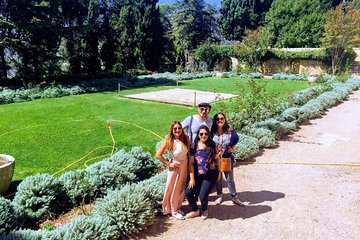Small-Group Tour to Beiteddine and Deir El Qamar with Lunch and Tickets
Share this tour

Offered languages
- English
Embark on a captivating journey through Lebanon's rich history and stunning landscapes with our exclusive Small-Group Tour to Beiteddine and Deir El Qamar. Immerse yourself in the timeless charm of these historic towns as our expert guides lead you through their fascinating stories and architectural wonders. From the majestic Beiteddine Palace, a masterpiece of Lebanese heritage, to the quaint streets and ancient structures of Deir El Qamar, every moment promises to enchant and inspire. Indulge in a delicious traditional lunch, savoring authentic flavors amidst breathtaking scenery. With tickets included and a small group setting ensuring personalized attention, this tour guarantees an unforgettable exploration of Lebanon's cultural treasures.
What's Included
Meeting and pickup
we pick up travelers from any destinations in Beirut ( Hotel, Airbnb or residence )
Itinerary
-
1
Beiteddine Palace or ‘House of Faith’ is a 19th-century palace in Beiteddine, Lebanon. It hosts the annual Beiteddine Festival and the Beiteddine Palace Museum. Emir Bashir Chehab II, who later became the ruler of the Mount Lebanon Emirate, built the palace between 1788 and 1818. After 1840, the palace was used by the Ottomans as a government building. During the French Mandate it served as a local administrative office. In 1943, the palace was declared the president's official summer residence. During the Lebanese Civil War it was heavily damaged. Parts of the palace are today open to the public while the rest is still the president's summer residence.
1 hour 30 minutes • Admission ticket included -
2Deir el Qamar
Deir al-Qamar, meaning "Monastery of the Moon" is a village located south-east of Beirut and five kilometres outside of Beiteddine palace in the Chouf District of the Mount Lebanon. Deir El Qamar was the first village in Lebanon to have a municipality in 1864, and it is the birthplace of many well known personalities, such as artists, writers, and politicians. People from all religious backgrounds lived there and the town had a mosque, synagogue and Christian churches. In the year 1860, Deir al-Qamar was destroyed during the civil war between Druze and Christians during which the town was set ablaze. Napoleon III sent a French contingent to rebuild it, recalling France ancient role as protector of the Christians in the Ottoman Empire as established by a treaty in 1523. In 1864, Deir el-Qamar elected the first municipality in the Arab provinces of the Ottoman Empire. The village retains a remarkable picturesque appearance with typical stone houses with red tile roofs.
1 hour • Admission ticket free -
3Fakhreddine's Mosque
Fakhreddine Mosque with its octagonal minaret is a mosque in Deir el Qamar, Lebanon. Built in 1493 and restored in the sixteenth century by Fakhreddine 1st, it is the oldest mosque in Mount Lebanon.
15 minutes • Admission ticket free -
4Saydet El Talle Church
The Church of Saidet et Tallé and translated as Our Lady of the Hill is one of the most important historical and religious sites in Deir el Qamar and dates to the 15th century. Monk Nicolas Smisaati built a church on the site over the ruins of an old Phoenician temple dedicated to the goddess Astarte that was later destroyed by an earthquake in 859. According to the Maronite Heritage web site, "the legend says that there was a Druze Emir in Baakline looking at the hill of Dar El Kamar. He saw a light coming out of the hill so he gathered his soldiers and ordered them to go in the morning and dig in the land. He said to them: 'If you find an Islamic symbol, build a mosque. If you find a Christian symbol, build a church." In the morning, the soldiers went and found a rock with a cross on it and under the cross there was the moon and venus. That was the sign that in the distant past there was a temple dedicated to the moon and venus and later it became a church.
15 minutes • Admission ticket free
Additional info
- Specialized infant seats are available
- Suitable for all physical fitness levels
Tags
Cancellation Policy
For a full refund, cancel at least 24 hours before the scheduled departure time.
Show more
Cancellation Policy
- For a full refund, you must cancel at least 24 hours before the experience’s start time.
- If you cancel less than 24 hours before the experience’s start time, the amount you paid will not be refunded.
- Any changes made less than 24 hours before the experience’s start time will not be accepted.
- This experience requires a minimum number of travelers. If it’s canceled because the minimum isn’t met, you’ll be offered a different date/experience or a full refund.
You can cancel up to 24 hours in advance of the experience for a full refund.
Your guide to the flawless travel experience





